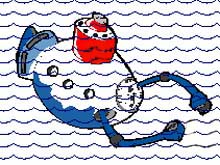
These lesson plans focus on the Lost City 2005 cruise.
Education Lesson Plans
Learn about the Technology being used on the Lost City Expedition.
The National Oceanic and Atmospheric Administration (NOAA) has a great opportunity to reach out in new ways to teachers, students, and the general public through its ocean exploration efforts and share the excitement of daily at-sea discoveries and the science behind its major ocean exploration initiatives with the people around the world. The Lost City 2005 Expedition presents a unique opportunity to engage explorers of all ages as we journey to a world that few have seen, a unique hydrothermal vent site unlike any other known anywhere else on the planet to date. Discovered just five years ago as scientists happened upon it one late December evening using a camera system mounted on a robotic vehicle, Drs. Deborah Kelley (University of Washington, UW) and Bob Ballard (University of Rhode Island) and their science teams will conduct further explorations of this unusual site and the unusual life forms it supports, with Dr. Kelley controlling the mission from her land-based Control Center at the UW, and Dr. Ballard working on site from on board the NOAA Ship Ron Brown.
Educators and scientists working with NOAA during July 2005 developed a series of inquiry- and National Science Education Standards-based lesson plans for students in Grades 5 –12 that are specifically tied to the Lost City 2005 Expedition. These lesson plans focus on cutting-edge ocean exploration and research using state-of-the-art technologies. Lessons focus on the biological communities at the Lost City Hydrothermal Field; investigating Lost City Hydrothermal Field ecosystems using remotely operated vehicles; pH, buffers, and chemistry of the Lost City hydrothermal chimneys; and the structure and origin of the Atlantis Massif, to name of few of the topics.For More Information
Contact Paula Keener-Chavis, national education coordinator for the NOAA Office of Ocean Exploration, for more information.
Other lesson plans developed for this Web site are available in the Education Section.
Grades 5-6
Animals of the Lost City (6 pages, 325k)
Focus
- (Life Science) Biological communities at the Lost City Hydrothermal Field
In this activity, students will be able to compare and contrast living organisms typically found at hydrothermal vent communities associated with volcanic activity with those found at vent communities of the Lost City hydrothermal field, and explain the difference between geologic processes that produce the Lost City Hydrothermal Field and processes that produce previously discovered hydrothermal vents.
What’s That? (7 pages, 356k)
Focus - (Life Science/Physical Science) Investigating Lost City hydrothermal field ecosystems by remotely operated vehicles
In this activity, students will be able to describe a sampling strategy for investigating an unknown area, and will be able to explain why this strategy is appropriate for such an investigation; identify and discuss some of the limitations faced by scientists investigating unexplored areas of the deep ocean, and discuss how an autonomous underwater vehicle such as the Autonomous Benthic Explorer (ABE) can contribute to discoveries such as the Lost City Hydrothermal Field.
Grades 7-8
Towers of the Lost City (8 pages, 370k)
Focus - (Physical Science/Earth Science) pH, buffers, and chemistry of the Lost City hydrothermal chimneys
In this activity, students will be able to define a buffer, and explain in general terms the carbonate buffer system of seawater; define pH, and contrast the pH of hydrothermal vent fluids at Lost City with those associated with black smokers, and describe the process through which hydrothermal chimneys are formed at Lost City, and identify the primary chemicals involved in this process.
I, Robot, Can Do That! (9 pages, 357k)
Focus - (Physical Science/Life Science) Underwater Robotic Vehicles for Scientific Exploration
In this activity, students will be able to describe and contrast at least three types of underwater robots used for scientific explorations, discuss the advantages and disadvantages of using underwater robots in scientific explorations, and identify robotic vehicles best suited to carry out certain tasks.
Grades 9-12
Lost City Chemistry Detectives (6 pages, 326k)
Focus - (Chemistry/Earth Science) Chemistry of the Lost City Hydrothermal Field
In this activity, students will be able to compare and contrast the formation processes that produce black smokers and the Lost City hydrothermal field, describe the process of serpentinization and how this process contributes to formation of chimneys at the Lost City hydrothermal field, and describe and explain the chemical reactions that produce hydrogen and methane in Lost City hydrothermal vent fluids.
Massif Mystery (7 pages, 327k)
Focus - (Earth Science) Structure and Origin of the Atlantis Massif
In this activity, students will be able to compare and contrast basalt, gabbro, and peridotite; explain what the presence of these rocks may suggest about the origin of formations where they are found; and describe and interpret research data that suggest possible origins of the Atlantis Massif.
Where’s Dinner? (6 pages, 334k)
Focus - (Life Science) Trophic relationships in biological communities of the Lost City Hydrothermal Field
In this activity, students will be able to compare and contrast primary production in biological communities and cold seeps and hydrothermal vents, describe and discuss probable primary production processes in biological communities of the Lost City Hydrothermal Field, and infer probable trophic relationships among macrofauna of the Lost City Hydrothermal Field.
Strange Bugs (9 pages, 369k)
Focus - (Physical Science/Chemistry) Chemistry of the Lost City hydrothermal chimneys


























